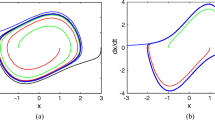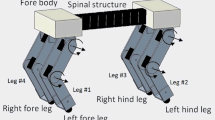Abstract.
The concerted and self-organizing behavior of spinal cord segments in generating locomotor patterns is modulated by afferent sensory information and controlled by descending pathways from the brainstem, cerebellum, or cortex. The purpose of this study was to define a minimal set of parameters that could control a similar self-organizing behavior in a two-dimensional neural network. When we implemented synaptic depression and active membrane repolarization as two properties of the neurons, the two-dimensional neural network generated traveling waves. Their wavelength and angle of propagation could be independently controlled by two parameters that modulated excitatory premotor neurons and inhibitory commissural neurons. It is further demonstrated that the selection of wave parameters corresponds to the selection of quadruped gaits.
Similar content being viewed by others
Author information
Authors and Affiliations
Additional information
Received: 30 July 2001 / Accepted in revised form: 17 April 2002
Correspondence to: A. Kaske (e-mail: alexander.kaske@mtc.ki.se, alexander.kaske@vglab.com)
Rights and permissions
About this article
Cite this article
Kaske, A., Winberg, G. & Cöster, J. Emergence of coherent traveling waves controlling quadruped gaits in a two-dimensional spinal cord model. Biol. Cybern. 88, 20–32 (2003). https://doi.org/10.1007/s00422-002-0335-0
Issue Date:
DOI: https://doi.org/10.1007/s00422-002-0335-0




